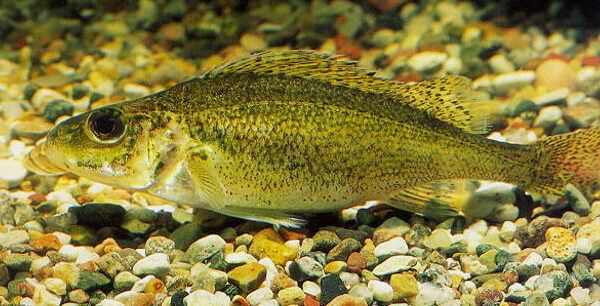Eurasian Ruffe

Species at a Glance
The Eurasian ruffe (Gymnocephalus cernuus) is a small but aggressive member of the perch family. Because of its high growth rate, reproductive success, and ability to adapt to a wide range of environments, it is considered a serious threat to both aquatic environments and commercial and sport fishing industries.
Species Description
The Eurasian ruffe has a small, deep, compressed body that is usually 10-15 cm (4-6 in) in length and rarely exceeds 25.5 cm (10 in). It resembles a yellow perch, but lacks head scales and has the markings of a walleye. Coloration is green-brown above with dark patches on lighter brown sides. The body is slimy when handled, and it has sharp spines on the dorsal fin and gill covers, making it very undesirable to predators.
Native & Introduced Ranges
Native to the fresh and brackish water areas of Eurasia, the Eurasian ruffe was introduced into Lake Superior in the mid-1980s. It most likely escaped during the release of ballast water carried by ships.
Since its introduction, the ruffe has rapidly increased in the St. Louis River at Duluth, Minnesota and continues to spread throughout the upper Great Lakes. Because ballast water is also likely responsible for the ruffe’s movement from lake to lake, expansion into the lower Great Lakes is likely.
Biology & Spread
The Eurasian ruffe grows and matures quickly, with females reaching reproductive maturity at age two and males after just one year. They can spawn in a wide range of temperatures, habitats, and on just about any substrate. They are opportunistic feeders, preying on aquatic insects, bottom dwelling organisms, and occasionally the eggs of other fish. There is very little predatory pressure on the Eurasian ruffe, as few species will feed on them, only doing so if other food sources become scarce.
Habitat
The Eurasian ruffe can tolerate a wide range of environmental conditions including degraded waters and varying salinities, depths, and nutrient levels. Because of their adaptability, they survive in a variety of habitat types including lakes, large and small rivers, estuaries, and ponds.
Impacts
Threat to Biodiversity
As the number of Eurasian ruffe increases, there is less food and habitat available for native fish with similar diets and feeding habits. Because they mature quickly, have a high reproductive rate, and can easily adapt to new environments, this species has a competitive advantage over native fish. Populations of yellow perch, walleye, and a number of small forage fish have all declined in locations where the Eurasian ruffe has been established. Their well-developed sensory system also helps them detect small vibrations given off by both predators and prey allowing them to avoid predators and find prey in nearly complete darkness.
Prevention & Control
Early detection of new Eurasian ruffe populations is vital in slowing or preventing their spread. Anglers are often the first to discover new populations because they are commonly caught by hook and line. Know how to identify the Eurasian ruffe. Always check for and remove any plants, mud, and debris from boats, trailers, clothing, and equipment before leaving a water body. Drain all water from bait buckets, bilges, and live wells before transporting to new areas. Clean all gear and equipment with either hot water (140°F/60°C), or salt water, OR let boats and equipment dry thoroughly for at least five days before entering a new water body.
References:
- Fuller, P.G., Jacobs, J., Larson, and Fusaro, A. 2012. Gymnocephalus cernuus. USGS Nonindigenous Aquatic Species Database. Gainesville, FL.
- Hajjar, R. 2002. Introduced species summary project: Ruffe (Gymnocephalus cernuus). Columbia University.



